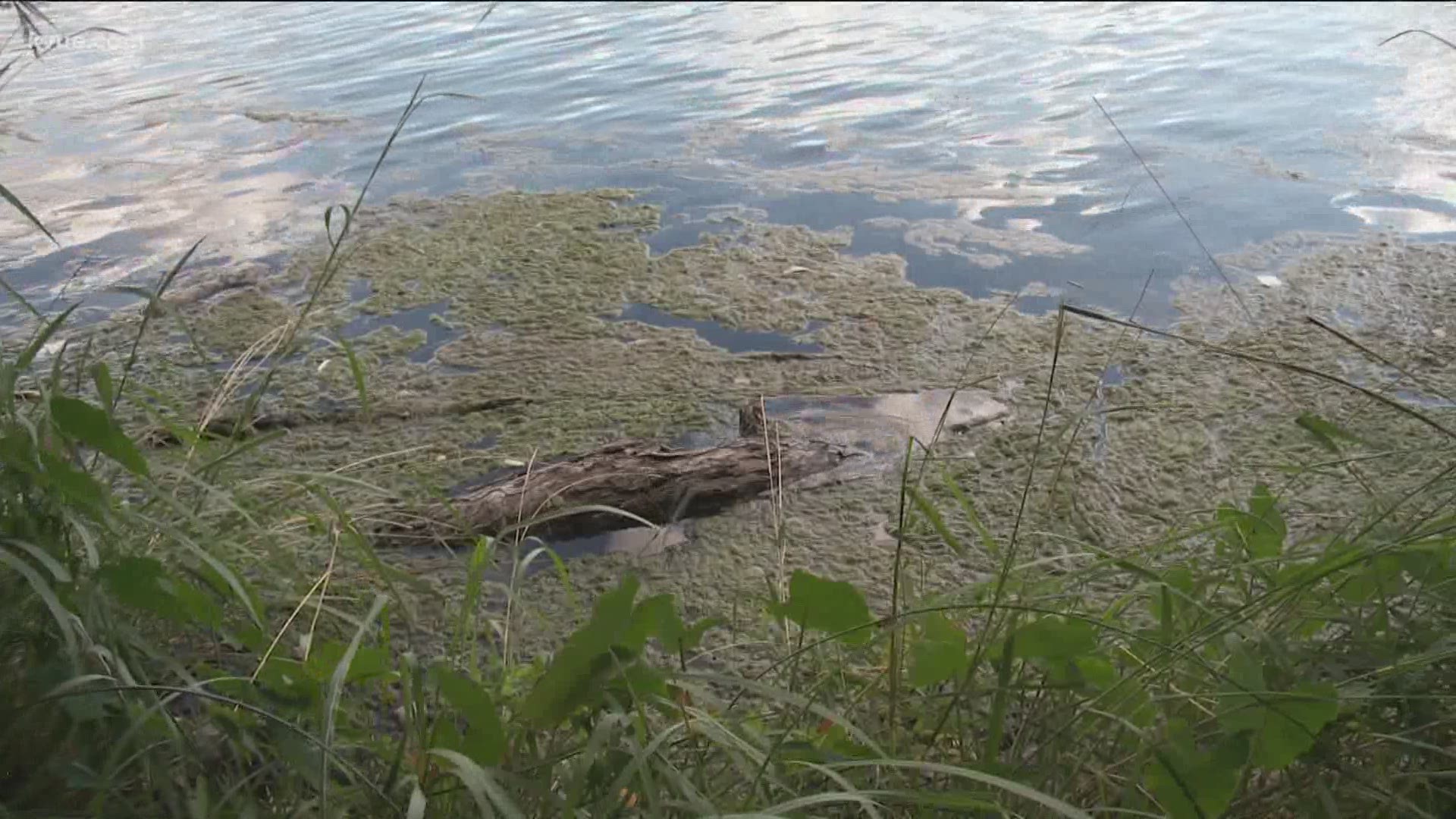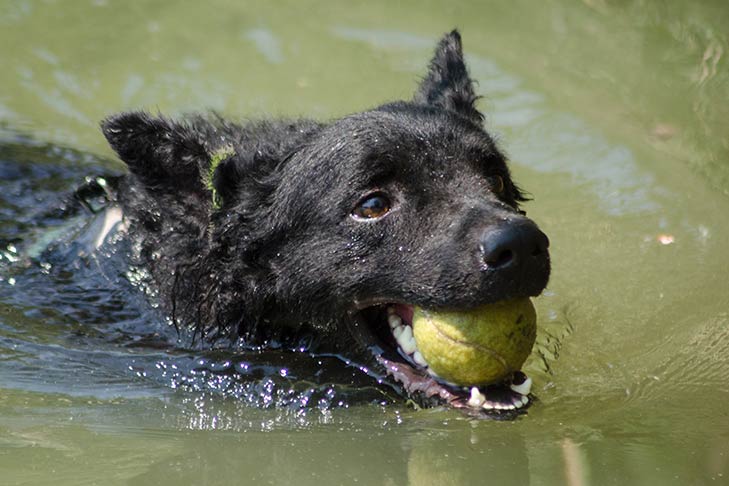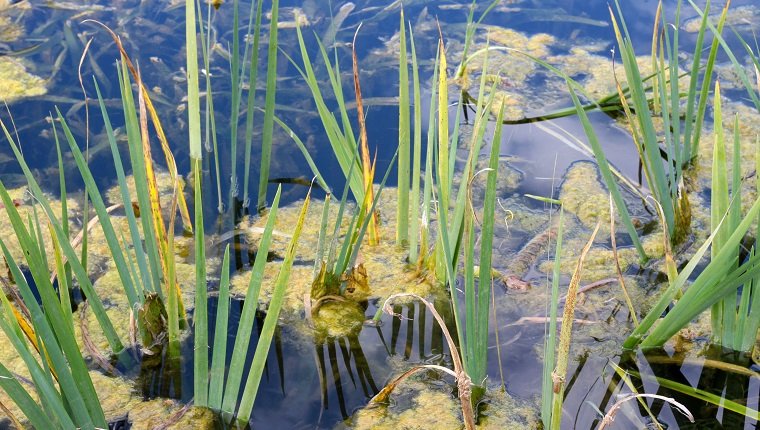Blue-green algae can be deadly to dogs, and recent blooms in Austin, TX serve as a reminder to keep our pets safe. The algae produce toxins that are life-threatening and there is no cure or antidote for poisoning.
The city’s Watershed Protection Department has warned dog owners to keep their pets away from the blue-green algae growths, which have been found in Red Bud Isle and Jessica Hollis Park. Ingesting the toxic algae can lead to liver and respiratory failure, as well as neurological issues in dogs.
It’s important to be vigilant and avoid letting dogs swim or paddle in lakes and ponds that may contain blue-green algae.

Credit: www.kvue.com
Understanding Blue-green Algae And Its Dangers
Blue-green algae, also known as cyanobacteria, can be found in lakes, ponds, and rivers, and is known to produce toxins that can be harmful to dogs, humans, and other animals. The recent blooms of blue-green algae in Austin, Texas, serve as a stark reminder of the dangers these microscopic organisms can pose to our beloved pets. It is crucial for pet owners to be aware of the risks and take necessary precautions to keep their furry friends safe. In this article, we will delve deeper into the topic of blue-green algae, exploring what it is, the toxins it produces, and the life-threatening effects it can have on dogs and other animals.
What Is Blue-green Algae Aka Cyanobacteria
Blue-green algae, scientifically known as cyanobacteria, is a type of microscopic organism that can be found in freshwater environments such as lakes, ponds, and rivers. Despite its name, blue-green algae is not a true algae, but rather a type of bacteria capable of photosynthesis. These organisms are typically green in color, but can also appear blue, brown, or red, depending on the specific species and environmental conditions.
Toxins Produced By Blue-green Algae
Blue-green algae are known for producing toxins, which can pose serious health risks to animals and humans. The primary toxins produced by these organisms are hepatotoxins and neurotoxins. Hepatotoxins target the liver, causing damage and impairment of its vital functions. On the other hand, neurotoxins affect the nervous system, leading to neurological symptoms and complications.
Life-threatening Effects On Dogs And Other Animals
The ingestion of blue-green algae or exposure to its toxins can have life-threatening effects on dogs and other animals. Dogs are particularly susceptible to the harmful effects of this toxic algae due to their tendency to swim and drink from bodies of water. The symptoms of blue-green algae poisoning in dogs can manifest rapidly and include vomiting, diarrhea, difficulty breathing, seizures, and even death.
It is important for pet owners to be vigilant and take preventive measures to keep their dogs safe from blue-green algae. Avoid letting your dog swim or drink from bodies of water where blue-green algae blooms are present or suspected. If you suspect that your dog has come into contact with blue-green algae or is showing symptoms of poisoning, seek immediate veterinary care. Remember, there is currently no antidote for blue-green algae poisoning, so prevention is key in keeping our furry companions safe.

Credit: www.akc.org
Recent Blooms And Dangerous Algae In Austin, Tx
Recent blooms of dangerous blue-green algae in Austin, TX serve as a reminder to pet owners to keep their dogs safe. Exposure to this toxic algae can be life-threatening to animals, and there is no cure or antidote. It is important to avoid letting dogs swim or drink water from lakes and ponds that may contain blue-green algae.
feline, to be aware of the dangers that blue-green algae can pose. The Watershed Protection Department in Austin, TX has issued a warning regarding recent blooms of this dangerous algae in the area.Warning From Austin’s Watershed Protection Department
The Watershed Protection Department in Austin, TX is urging pet owners to be cautious and keep their dogs away from areas with recent blue-green algae blooms. The department has identified likely blooms at Red Bud Isle and Jessica Hollis Park on Lake Austin, and it is crucial for dog owners to avoid these locations to protect their beloved pets.Locations Of Likely Blooms
According to the Watershed Protection Department, recent blooms of blue-green algae have been observed at Red Bud Isle and Jessica Hollis Park on Lake Austin. These areas should be avoided to prevent potential exposure to the harmful toxins produced by the algae. It is important for dog owners to be vigilant and keep their pets away from these locations.Presence Of Harmful Neurotoxin
Blue-green algae contains a harmful neurotoxin that can be fatal to dogs if ingested. The toxins produced by this algae can lead to liver and respiratory failure as well as neurological issues in dogs. Unfortunately, there is currently no known cure or antitoxin for blue-green algae poisoning in dogs. It is vital for pet owners to be aware of the dangers and take proactive measures to keep their dogs safe from this toxic algae. In conclusion, recent blooms of blue-green algae in Austin, TX serve as a reminder for pet owners to prioritize the safety of their dogs. The warning from the Watershed Protection Department, the identified locations of likely blooms, and the presence of harmful neurotoxins highlight the urgency of keeping pets away from these potentially dangerous areas. By staying informed and taking necessary precautions, pet owners can help protect their furry friends from the life-threatening effects of blue-green algae poisoning.Protecting Dogs From Blue-green Algae Exposure
Blue-green algae can be found in lakes, ponds, and rivers, and exposure to its toxins can be fatal for dogs. As responsible pet owners, it is crucial to take steps in protecting our furry friends from this potential danger. Here are some measures you can take to keep your dog safe:
Avoid Lakes And Ponds Suspected Of Containing Algae
Avoiding lakes and ponds suspected of containing blue-green algae is the first step in preventing exposure. If there are visible signs of algal blooms or if you have heard reports of algae in a particular body of water, it is best to keep your dog away from it. Even a small amount of exposure can have severe consequences for your pet.
Preventing Dogs From Swimming Or Paddling In Infested Water
It’s important to prevent your dog from swimming or paddling in water that is infested with blue-green algae. Dogs are naturally drawn to water, especially on hot days, but it is crucial to prioritize their safety. Keep a close eye on your dog and discourage any attempts to enter water known or suspected to be contaminated with algae.
Recognizing Symptoms Of Blue-green Algae Poisoning
Being aware of the symptoms of blue-green algae poisoning can help you act quickly and seek medical attention for your dog. Some common symptoms include:
- Vomiting
- Diarrhea
- Difficulty breathing
- Excessive drooling
- Weakness or lethargy
- Seizures
- Disorientation
- Loss of appetite
- Jaundice (yellowing of the skin or eyes)
If you notice any of these symptoms after your dog has been near water suspected of having blue-green algae, it is crucial to seek veterinary attention immediately. Time is of the essence when it comes to treating blue-green algae poisoning.
Protecting our furry companions from blue-green algae exposure is our responsibility as pet owners. By being vigilant and taking preventative measures, we can ensure the safety and well-being of our beloved dogs.

Credit: www.akc.org
The Serious Health Risks For Dogs
Ingesting toxic blue-green algae can present a host of grave health concerns for dogs. Dr. Nipuni Ratnayaka, an associate veterinarian at Austin Pets Alive!, warns that dogs exposed to this toxic algae may suffer from:
Liver And Respiratory Failure
Blue-green algae toxins can severely damage a dog’s liver, leading to liver failure. Additionally, these toxins can affect the respiratory system, causing respiratory failure. These life-threatening conditions can arise rapidly and may not be reversible.
Neurological Issues
The harmful neurotoxins produced by blue-green algae can impact a dog’s nervous system, resulting in neurological issues. Dogs may experience seizures, muscle tremors, confusion, disorientation, and even coma. These neurological symptoms require immediate medical attention and can have long-lasting effects.
Lack Of Antitoxin Or Cure
One of the most concerning aspects of blue-green algae poisoning is that there is no known antidote or cure. Veterinary professionals have not yet discovered a specific antitoxin to counteract the effects of the toxins. This means that once a dog has ingested the algae and shows symptoms, treatment focuses on supportive care to manage the symptoms and prevent further complications.
It is crucial for dog owners to stay informed about blue-green algae blooms in their local areas and take steps to keep their pets safe. Keeping dogs away from lakes, ponds, or any water bodies with suspected or confirmed blue-green algae presence is paramount. Remember, prevention is key when it comes to protecting our furry friends from the serious health risks posed by blue-green algae.
Awareness And Prevention Efforts In Austin, Tx
Recent blooms of blue-green algae in Austin, TX serve as a reminder to keep our pets safe. Blue-green algae can be deadly to dogs, so it’s important to avoid lakes and ponds where these blooms occur to prevent exposure to the harmful toxins.
Importance Of Vigilance For Pet Owners
Pet owners in Austin, TX need to be vigilant when it comes to the safety and well-being of their furry friends. With recent blooms of blue-green algae in the area, it is crucial to understand the potential danger it poses to dogs. These algae, also known as cyanobacteria, can be found in lakes, ponds, and rivers, and their toxins can be deadly.
The first step in keeping our pets safe is to recognize the signs of blue-green algae and avoid any contact. Dogs are especially vulnerable as they often enjoy swimming and playing in water bodies. It is important to remember that visual inspection alone cannot determine whether the algae are toxic or not. Therefore, assuming toxicity is essential to prevent any potential harm.
Toxicity is a serious concern when it comes to blue-green algae. Ingesting or coming into contact with the toxins produced by these bacteria can lead to severe health issues, including liver and respiratory failure, as well as neurological problems. Sadly, there is no known cure or antitoxin for blue-green algae poisoning, which is why prevention is crucial.
Assuming Toxicity Of Algae And Avoiding Contact
Avoiding contact with blue-green algae should be a top priority for pet owners in Austin, TX. Even a small amount of toxin can be harmful, so it’s better to be safe than sorry. Here are a few precautions to take:
- Avoid letting your dog swim or drink from water bodies that may contain blue-green algae
- Keep an eye out for any signs of algae blooms, such as floating green or blue-green scum on the water surface
- Prevent your pet from accessing areas where you suspect the presence of blue-green algae
- If you suspect your dog has come into contact with blue-green algae, rinse them thoroughly with clean water immediately
Remember, being cautious and assuming that all algae could be toxic is the best approach to protect your pet from potential harm. It’s always better to err on the side of caution and prevent any contact altogether.
Educating The Public And Spreading Awareness
Increasing public awareness about the dangers of blue-green algae is crucial in preventing any harm to our beloved pets. The city of Austin, TX, has taken several initiatives to educate the public and spread awareness about this issue. These efforts include:
- Providing information through public service announcements and social media campaigns
- Organizing educational events and workshops for pet owners
- Distributing informational brochures and posters at community centers and veterinary clinics
- Collaborating with local organizations, such as Austin Pets Alive!, to disseminate information to a wider audience
By working together, we can ensure that pet owners in Austin, TX, are well-informed about the risks associated with blue-green algae and take the necessary precautions to keep their pets safe. Remember, prevention is the key to protecting our furry companions and ensuring their well-being.
Frequently Asked Questions Of Blue-green Algae Can Kill Dogs, & Recent Blooms In Austin, Tx Remind Us To Keep Pets Safe
Can Dogs Survive Blue-green Algae Poisoning?
Dogs cannot survive blue-green algae poisoning as it can be life-threatening. These toxin-producing cyanobacteria can be found in lakes, ponds, and rivers. There is no antidote for this poisoning, and it can quickly become fatal. It is important to keep dogs away from water bodies suspected to contain blue-green algae to protect their health.
Is Lake Travis Safe For Dogs 2023?
Lake Travis may not be safe for dogs in 2023 due to the presence of toxic blue-green algae, which can be life-threatening and has no antidote. It is recommended to keep dogs away from lakes and ponds that may contain this algae to protect their health.
What Algae Kills Dogs In Austin?
Blue-green algae found in lakes, ponds, and rivers in Austin can kill dogs. The neurotoxin in this algae can be life-threatening and there is no cure for poisoning. Keep your dog away from areas with blue-green algae to protect their health.
How Do I Protect My Dog From Blue-green Algae?
To protect your dog from blue-green algae: 1. Keep them away from lakes and ponds suspected of containing the algae. 2. Don’t let them swim or paddle in these areas. 3. Be aware that blue-green algae can be toxic, causing liver and respiratory failure, as well as neurological issues in dogs.
4. There is no cure for blue-green algae poisoning, so prevention is key. 5. Stay vigilant and keep your dog safe from this potentially life-threatening toxin.
Conclusion
Blue-green algae can be deadly for dogs, and recent blooms in Austin, Texas serve as a sobering reminder for pet owners to prioritize their pets’ safety. The toxins produced by this algae are extremely harmful and can lead to liver and respiratory failure, as well as neurological issues.
Unfortunately, there is no cure or antidote for blue-green algae poisoning, making prevention all the more crucial. It’s important to keep dogs away from lakes and ponds suspected of containing blue-green algae to ensure their well-being and avoid any potential tragedies.

